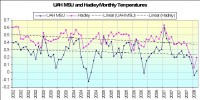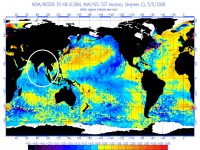By Andrew Bolt, Australia Herald Sun
What the world should be learning from this terrible loss of at least 60,000 people in the cyclone that hit Burma last week is that tyrannies kill more surely than any freak of weather. But Al Gore, who won a Nobel “Peace” Prize for terrifying people with his error-riddled An Inconvenient Truth, wants you to blame instead his pet bogeyman. Tremble, sinners, before the wrath of a hot planet! In an interview on America’s NPR on Tuesday, Gore claimed Cyclone Nargis was actually part of a pattern. This cyclone that hit Burma is a “consequence” of global warming? Gore should die of shame to peddle such self-serving deceptions.
The world has not warmed in a decade, says the Hadley Centre and two of the three other institutions that measure its temperature. Any link between hurricanes and warming is highly disputed by scientists, with “evidence both for and against”, says the American Meteorological Society. The data is “insufficiently reliable to detect trends on the frequency of extreme cyclones”, says a recent paper in Science by world authority Chris Landsea.
The cyclone that hit Burma was just a category three storm - not a category five - and less deadly than worse cyclones that struck Bangladesh in 1970 and 1991. What’s more, Gore concedes the record breaker was 50 years ago, before the world got this gassy.
So there’s no recent warming, no agreed link with cyclones, no trend of worse cyclones, and nothing unusually strong about the one that hit Burma.
But what’s worse this time is that Gore’s blundering attempts to blame global warming for Burma’s agony distracts attention from the real causes of this catastrophe - despicable causes we may at least hope to do something about.
But in Burma as many as 100,000 are now feared dead - victims not of global warming, but of a tyranny that has left them poor and defenceless. Burma, a former British colony, was once the rice-bowl of South-East Asia, but in 1962 a bunch of generals took over with a misty-eyed plan to impose on their 50 million people the “Burmese Way to Socialism”. Read more here.
By Adrienne Selko, Industry Week
The U.S. Energy Information Administration’s (EIA) released an analysis of the Lieberman-Warner climate change bill (S. 2191), which causes the National Association of Manufacturers (NAM) to comment that the bill has sobering economic and social costs, particularly the hike in future natural gas prices. “Natural gas prices are the linchpin for manufacturers in any proposed climate change solution,” said NAM CEO John Engler. “Manufacturers are the most natural gas intensive sector, and affordable natural gas is essential to the long-term competitiveness of manufacturing and the U.S. economy. According to the EIA, the price of natural gas would nearly double from $11 per MMBTU today to $19 per MMBTU under the Lieberman-Warner climate change bill. Clearly, the proposed legislation now before Congress runs the risk of doing more economic harm than environmental good,” he said.
Engler added that the NAM commissioned a joint study with the American Council for Capital Formation (ACCF) which found that the Lieberman-Warner climate change bill would “reduce U.S. gross domestic product by up to $210 billion per year by 2020—imposing more economic damage than the housing financial crisis each and every year-- including employment losses of up to 1.8 million jobs in 2020. With the nation on the brink of recession, federal climate change policies that would further slow the economy in return for indeterminate benefits are ill-advised.”
“We can not continue to propose increases in the price of natural gas while failing to expand domestic gas exploration and increased investment in nuclear energy technology,” Engler concluded. See story and more here.
By Jeff Poor, Business and Media Institute
Using tragedy to advance an agenda has been a strategy for many global warming activists, and it was just a matter of time before someone found a way to tie the recent Myanmar cyclone to global warming. Former Vice President Al Gore in an interview on NPR’s May 6 “Fresh Air” broadcast did just that. He was interviewed by “Fresh Air” host Terry Gross about the release of his book, “The Assault on Reason,” in paperback.
“And as we’re talking today, Terry, the death count in Myanmar from the cyclone that hit there yesterday has been rising from 15,000 to way on up there to much higher numbers now being speculated,” Gore said. “And last year a catastrophic storm from last fall hit Bangladesh. The year before, the strongest cyclone in more than 50 years hit China - and we’re seeing consequences that scientists have long predicted might be associated with continued global warming.” Gore claimed global warming is forcing ocean temperatures to rise, which is causing storms, including cyclones and hurricanes, to intensify. Read more here.
Icecap Note: Someone needs to let Al know that NOAA’s global 3000 buoys have shown a slight cooling not warming since their deployment in 2003. That temperatures according to satellites (MSU UAH) and the Hadley Center agree with cooling back to at least 2002.
 . See larger image here.
. See larger image here.
Another inconvenient truth is that major devastating storms have been part of the history of the region even back in the Little Ice Age in 1584 when a major cyclone killed 200,000. After a series of killer cyclones in the globally cold 1960s (1963, 22,000; 1965, 57,000 (3 storms), in 1970, during the peak of the mid 20th century cool period, the famous Bhola cyclone killed 300,000-500,000. Another Bangladesh storm in 1991, killed 150,000. See the top ten killer storms in this story today here.
Finally someone needs to show Al the current sea surface temperature analysis chart for the globe where most of the Pacific and Indian Ocean including the waters near Myanmar are cooler than the long term normal.

See full size image here


